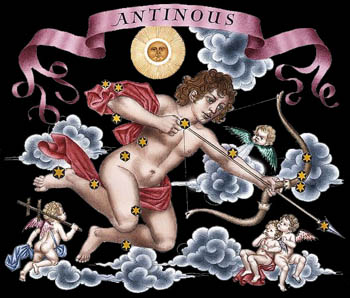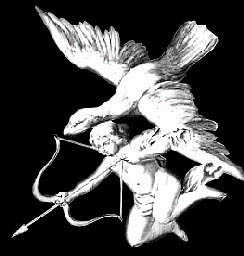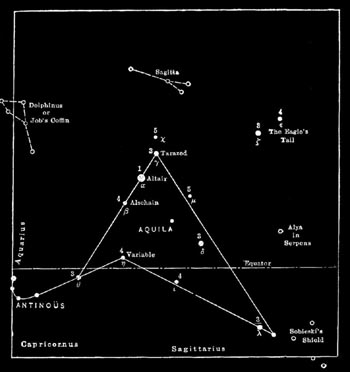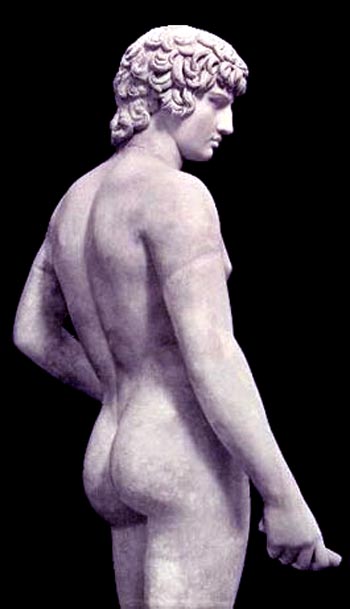
THE STAR OF ANTINOUS
T
"Hadrian declared that He had seen a star which he took to be that of Antinous, and gladly lent an ear to the fictitious tales woven by his associates to the effect that the star had really come into being from the spirit of Antinous and had then appeared for the first time."
-Cassius Dio, Epitome of Book 69
The star of Antinous was named shortly after the death of Antinous, perhaps in the year 131, when the Nile flooded over the embankments and a new star appeared in the sky to announce the deification of the new god. Hadrian's Astrologers noticed the new star which appeared suddenly within the constellation now known as Aquila, the Eagle.
The controversy continues whether it was a Super Nova, or a Comet that heralded the deification of Antinous as a heroic god of the celestial sphere. Did a Supernova occur, the birth of a star, at the high water mark of the Nile inundation, or did a comet appear suddenly in the early morning hours of the winter sky.
It is our belief that the miraculous star of Antinous was a Super Nova, and not a comet. Chinese astrologers recorded a comet to have occurred in the region of the constellation Aquila in the year 131-134 AD, however ancient astrologers would have known the difference between a stationary Super Nova and a moving comet, and as the comet would have been seen in what would have been the last hour of the early morning February sky, it seems unlikely that this would have been taken as a sign of anything as extraordinary and significant as the Star of Antinous is represented to have been understood. The Star of Antinous was an event that was seen by everyone across the entire Roman world....it was a celestial event of extraordinary parameters, something that was seen by everyone, everywhere, and an event that must have coincided with other significant events in the story of Antinous, for which reason the Star was connected with him.
A comet in the early morning hours of late January would not have been in any way as powerful s sign as a Super Nova which occurred in July or mid-summer, in conjunction with the Inundation of the Nile, when the Constellation of Antinous is high in the sky of the summer night, when the greatest number of people were gazing into the sky...there is every indication to suggest that a New Star appeared in the sky for the very first time which would mean a significant Super Nova, rather than a comet, which would move, whereas a super nova would have been stationary.
The Star of Antinous must have coincided with the miraculous Inundation of the Nile...the deification of Antinous was announced by the river of the earth and of the sky...the two miracles are one and the same.
Exploding stars are a common occurrence, they happen every night, perhaps even more frequently. The universe is so vast that in some portion a million stars could be exploding simultaneously that we can never see. But of those that we can see, a very significantly high number occur within or near the constellation Aquila.
Nova V1494 Aquilae
On December 1st, 1999, Nova V1494 Aquilae was discovered in the constellation Aquila near it's center star Delta Aquilae. 6,000 light years away, within the Milky Way, towards the center of our galaxy, a star exploded. Antinous is believed to have been born on November 27th, 111, his birthday was then four days before the Nova, which was 29 days before the millennium. The specific numbers are of little importance, but their proximity to famous events is. Hadrian did not fail to notice the significance of the Nova Aquilae of his time, like all gods, Antinous had announced his arrival upon never-ending Olympus. We must therefore not ignore this most recent stellar manifestation, and what it means to us.
Constellation Aquila with Nova
This new star in Aquila is a sign to remember Antinous, to look again into the sky and know that something vast is taking its course. It is an event of sacredness to Homosexuals, because it reminds us that once, almost two thousand years ago, our sexuality was approved and sanctified through Antinous, and immortalized by his star. In our time, we are in the midst of a similar sexual revolution, the gradual return of Homosexuality to blessedness, or at the very least toleration. As if to say that even the cosmos approves the change, in the sign of our patron saint and benefactor Antinous, another star, or perhaps even the same distant sun becomes inflamed with love for us. These recent Novas, the smaller one of 1995 called V1425 and the more astonishing V1494 are the first indication that the age of Antinous is approaching.
Hadrian was an educated and religious man, He could not easily have been led astray by flattery, and let us remember that he was a true mystic. He had no need of Astrologers, he could read the stars as well as they. In the winged embrace of the Eagle, a star had shown it's countenance.
A new constellation was drawn within Aquila that was named Antinous, and observed by Astrologers all around the world, as recently as the last century. But Antinous has vanished from the modern star map. In the Nineteenth Century, when Astronomy severed his ties to the mythological past, astronomers began to omit mention of Antinous. Perhaps they found it easier to erase than to explain who he was. There has never been need to economize the number of stars in the sky, yet he was ignored and almost forgotten. Like the city of Antinoopolis, the star has completely vanished.
The message of the Star transcends the negligence of astronomers having more spiritual symbolism than scientific. The star of Antinous is part of a great unfolding of the cosmos, that once glimpsed, leaves one with the impression of the true mechanism of the Universe, and forever changes how one walks through the daily world.
Situated near Capricorn, on the edge of the milky way, surrounded, enveloped or embraced by Aquila, the form which Jupiter took when he swooped down upon Ganymede and carried him off to heaven. Antinous is the New Ganymede. The ferocity of Jupiter's lust is like the hunger of an Eagle as it rips into a tender dove. The eagle is the only bird that has the power to hold Jupiter's thunder. The only creature able to fly in his proximity.
On Holy Mt. Ida near the city of Troy, as Ganymede tended his father's flocks, the greatest of the Gods descended upon him. Ganymede, whose name in Greek means "pleasure of the genitals," was not entirely consumed, and destroyed by the divine desire that ravished him. He was made into an immortal, an unprecedented occasion. Unlike his female indiscretions, who he generally raped and then abandoned to the fury of Juno, Zeus carries Ganymede to Olympus, body and soul, to serve as cup bearer of the Gods. Strangely safe from Juno's vengeance, she seems almost to accept Ganymede, as his place, though the lowliest and most servile of all Olympians, is the most sublime. It is he whose cup pours out the perpetual fountain of youth that is the immortality of the Gods. It is more than mystical poetry and lust that compels Zeus, the greatest of the gods, to entrust such power to a teenage boy.
Comparison to Antinous is poetic truth. The Astrologers were only revealing what they saw. A boy who in radiant form closely resembled Ganymede, having been carried away from his home by the living God of Rome. Antinous was taken from obscurity and placed at the very forefront of the world by Hadrian, the New Zeus, as unpredictable, and as glorious in deeds as the Father of the Sky. The eagle from earliest time has been a celestial and national symbol of power. The image of Strength, Justice, glory, Power, and the freedom of the sky, taking hold of a dove, becomes a conjunction of forces. Power and Love, Age and Youth, Majesty and Beauty, Justice and Peace, Strength and Weakness, Desire and Perfection, Logic and Wisdom...Life and Death.
But Antinous is far more than a luminous dove, there is intimation within the symbols of his remaining statues of a hidden nature, a deeper, darker sexuality. Several of his images are adorned with the prominence of a serpent, and his assumption into the mysteries of Hermes and Apollo comes laden with suggestions of snake worship. Within its many layers as a symbol, the snake is everything from sexual potency, the transmission of ecstatic vision, as in the Oracle of Delphi, Eve at the Tree of Knowledge, and the secret Gnosis attributed to Hermes Tristmegistus…Ouroboros. The serpent is a celestial symbol, in the form of the constellation Serpens just above Antinous, and in Hydra, the world Serpent that grasps the Egg, biting its own tail. Hadrian could not have failed to notice.
Through his death, Antinous fulfilled and accomplished the salvation of Ganymede, "pleasure of the genitals." Placed at the shore as it were, of our Galaxy, the Star of Antinous is the same star attributed to the God Attis. Antinous died in the Nile, Attis after castrating himself, died in the river Gallus.
The Two Stars
Shortly after the discovery of Nova V1494 Aquilae, astronomers focused an orbiting X-ray telescope called Chandra to take readings. They were very surprised to find that the temperature of the expanding and contracting white dwarf that had made the spectacle reached over 300,000 °C, which makes our Star of Antinous one of the hottest stars ever recorded. Their observations showed that thermal nuclear reactions were still taking place more than eight months after the initial explosion, something very unusual. Normally, after the Star explodes, it falls dormant, and slowly fades.
At first the Nasa observers recorded a pulsation every 40 minutes, the result of the expansion and contraction of the White dwarf star, but the they also recorded a second emanation, in their words:
"The other result
was an enormous flare of X-rays that lasted for 15 minutes. Nothing
like this has been seen before from a nova, and we don't know how to
explain it."
-Chandra X-Ray Observatory, press release
They concluded that perhaps there is not one but two stars orbiting around each other, the white dwarf responsible for the massive explosion, and a second, large red star whose hydrogen gas is sucked up by the gravitational force of its companion. The gases build upon the white dwarf and grow in heat and density until another explosion occurs. This process is repeated until the red star is either completely drained, becoming a dead, black dwarf, or it is able to regain some of its lost hydrogen during the explosion, maintaining a sort of equilibrium.
These new discoveries have taught the astronomers a great deal about Novas, but they have much to teach about the relationship between Antinous and one who believes in Him. The two stars in the constellation Aquila are an image of the gravity that pulls the lover to the Beloved. Like the red star, anyone who believes in Antinous is slowly absorbed by his power, surrendering more and more of the self, becoming one with the Beautiful white star, a process that I call Homotheosis. When Union is made, when the crucial breaking point has been achieved, and there is no longer a meaningful difference between the God and the Man, an explosion of light announces the occasion. Truly, the awakening of a single man, or a single star, is a cosmic event.
It draws into question the possibility that Nova V1494 Aquilae of December 1st, 1999, and the Nova that the court Astrologers of Hadrian detected may be one and the same, and therefore very Holy.
The birth of the Star of Antinous also may be connected to the star of Jesus that the wise men saw in the sky. It is also part of the cosmic drama that the religion of Mithras celebrated. All three stars are records of a great transformation taking place in the sky, the Precession of the Equinox. The path of the Sun had moved from the constellation Aries into the constellation Pisces, signaling the dawn of a New Age. Caused by an imperceptible wobble in the Earth's Axis, the entire dome of the sky moves slowly, or seems to. The place where the sun rises on the Spring Equinox moves slowly backward through the signs of the Zodiac, taking just over two thousand years to move from one sign to the next, until finally over the course of tens of thousands of years, it makes a full circle through the twelve houses. Then it starts its journey again, as it has done for millions of millions of years, and will continue to do with or without us.
It is not the stars that move necessarily, but we who are passengers on the Earth. There has been little significant change in the position of the cosmos for billions of years, but our perception of the stars changes constantly.
Very soon the Sun will move again. It has been two thousand years since the Sun entered Pisces, this was the sign that heralded the Birth of Jesus, as the sun stood, divided between powers, Antinous was born in the year 111 A.D. The present belief, which is very difficult to judge is that only 10 years remain before the Sun leaves Pisces and enters the next house, beginning the Age of Aquarius. This number is roughly in accordance with both the Babylonian-Greco-Roman calendar, and the uninfluenced Mayan calendar.
This is our sign, this is a message of things to come. The Age of Aquarius will bring unprecedented change. All the change that we have seen in the last hundred years is nothing compared to what will be. But the message of the celestial star is spiritual, it foretells the coming of a stranger, a man from beyond, who will start a new covenant and recover our faith with a new faith. He will come when we least expect him, and in an astonishing disguise.
Redraw the map of the stars
in the sky,
Unveil Antinous in the wings of the Eagle
Carried higher from the Earth,
Circling the cosmos for millions of millions of years.
These Stars seem to me
Like a theater of the absurd
Where mysteries play themselves out
Behind a translucent screen,
Only the gestures can be seen,
Leaving one with the impression
That something wonderful is about to happen.











